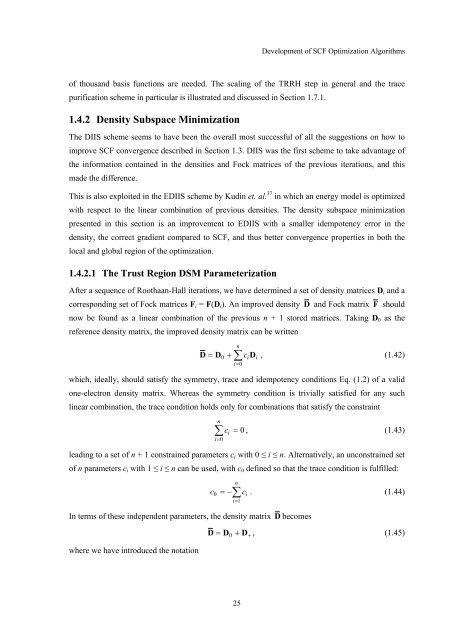Get my PhD Thesis
Get my PhD Thesis
Get my PhD Thesis
Create successful ePaper yourself
Turn your PDF publications into a flip-book with our unique Google optimized e-Paper software.
Development of SCF Optimization Algorithms<br />
of thousand basis functions are needed. The scaling of the TRRH step in general and the trace<br />
purification scheme in particular is illustrated and discussed in Section 1.7.1.<br />
1.4.2 Density Subspace Minimization<br />
The DIIS scheme seems to have been the overall most successful of all the suggestions on how to<br />
improve SCF convergence described in Section 1.3. DIIS was the first scheme to take advantage of<br />
the information contained in the densities and Fock matrices of the previous iterations, and this<br />
made the difference.<br />
This is also exploited in the EDIIS scheme by Kudin et. al. 37 in which an energy model is optimized<br />
with respect to the linear combination of previous densities. The density subspace minimization<br />
presented in this section is an improvement to EDIIS with a smaller idempotency error in the<br />
density, the correct gradient compared to SCF, and thus better convergence properties in both the<br />
local and global region of the optimization.<br />
1.4.2.1 The Trust Region DSM Parameterization<br />
After a sequence of Roothaan-Hall iterations, we have determined a set of density matrices D i and a<br />
corresponding set of Fock matrices F i = F(D i ). An improved density D and Fock matrix F should<br />
now be found as a linear combination of the previous n + 1 stored matrices. Taking D 0 as the<br />
reference density matrix, the improved density matrix can be written<br />
n<br />
= 0 +∑ ci<br />
i=<br />
0<br />
D D D , (1.42)<br />
which, ideally, should satisfy the symmetry, trace and idempotency conditions Eq. (1.2) of a valid<br />
one-electron density matrix. Whereas the symmetry condition is trivially satisfied for any such<br />
linear combination, the trace condition holds only for combinations that satisfy the constraint<br />
n<br />
i=<br />
0<br />
i<br />
∑ ci<br />
= 0 , (1.43)<br />
leading to a set of n + 1 constrained parameters c i with 0 ≤ i ≤ n. Alternatively, an unconstrained set<br />
of n parameters c i with 1 ≤ i ≤ n can be used, with c 0 defined so that the trace condition is fulfilled:<br />
c<br />
0<br />
n<br />
=−∑ c . (1.44)<br />
i=<br />
1<br />
i<br />
In terms of these independent parameters, the density matrix D becomes<br />
where we have introduced the notation<br />
D = D0 + D + , (1.45)<br />
25

















